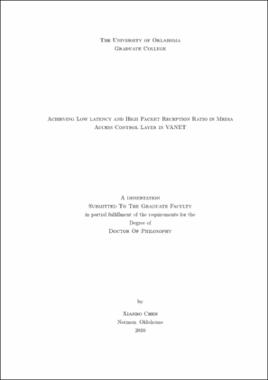| dc.contributor.advisor | Refai, Hazem H | |
| dc.creator | Chen, Xianbo | |
| dc.date.accessioned | 2019-04-27T21:31:19Z | |
| dc.date.available | 2019-04-27T21:31:19Z | |
| dc.date.issued | 2010 | |
| dc.identifier | 99263277702042 | |
| dc.identifier.uri | https://hdl.handle.net/11244/318893 | |
| dc.description.abstract | Vehicular ad hoc networks (VANETs) or inter-vehicle | |
| dc.description.abstract | communication (IVC) makes possible the development of a number of | |
| dc.description.abstract | innovative and powerful transportation system applications. VANET | |
| dc.description.abstract | technology proves an important extension of both cellular and | |
| dc.description.abstract | wireless local area networks (WLANs) currently used in the | |
| dc.description.abstract | transportation industry. It is widely recognized that the | |
| dc.description.abstract | transportation industry serves as an ideal platform for a large | |
| dc.description.abstract | number of existing and future wireless applications, many of which | |
| dc.description.abstract | have yet to be developed for commercial use. | |
| dc.description.abstract | Safety messaging is one of the most critical uses for VANET, | |
| dc.description.abstract | supporting a number of potential safety applications, e.g. emergency | |
| dc.description.abstract | electronic brake lights, lane change and pre-crash warning, among | |
| dc.description.abstract | others. Many applications require extremely low latency (less than | |
| dc.description.abstract | 100ms) and highly reliable (over 99\% packet delivery ratio) | |
| dc.description.abstract | communication services. In order to satisfy these critical | |
| dc.description.abstract | requirements, an efficient media access control (MAC) layer is | |
| dc.description.abstract | necessary. At the time of this writing, a de facto standard of VANET | |
| dc.description.abstract | MAC is being developed. | |
| dc.description.abstract | Extensive VANET MAC research with regard to safety applications has | |
| dc.description.abstract | yet to be done. The proposed base for the VANET future standard uses | |
| dc.description.abstract | an 802.11a media access layer whose performance-although studied-is | |
| dc.description.abstract | known to contain deficiencies and was accomplished outside the | |
| dc.description.abstract | VANET context. These factors motivated the author to initiate the | |
| dc.description.abstract | study of VANET and MAC. | |
| dc.description.abstract | In this work, MAC for VANET MAC is extensively researched, and a | |
| dc.description.abstract | history of MAC is initially reviewed. The special and critical | |
| dc.description.abstract | requirements of VANET MAC are presented and four major categories | |
| dc.description.abstract | were investigated and analyzed. Because the under-development of | |
| dc.description.abstract | 802.11p is based on the IEEE 802.11a, special consideration is given | |
| dc.description.abstract | with regard to the performance of 802.11a MAC and associated | |
| dc.description.abstract | requirements. Extensive research enhancements centering on safety | |
| dc.description.abstract | applications of the 802.11 MAC are conducted. The author's research | |
| dc.description.abstract | generated a platform in which VANET performance can be | |
| dc.description.abstract | quantitatively evaluated, analyzed, and verified. The quantitative | |
| dc.description.abstract | behavior of the current protocols/algorithms, which include delay | |
| dc.description.abstract | and packet delivery ratio, are presented on this platform. | |
| dc.description.abstract | Furthermore, the future protocol and algorithm proposals can be | |
| dc.description.abstract | added into this platform so that a faster research cycle can be | |
| dc.description.abstract | achieved. Through theoretical analysis and simulation, this | |
| dc.description.abstract | investigation shows that current proposed VANET MAC and 802.11a MAC | |
| dc.description.abstract | enhancements have yet met the critical requirements of VANET. The | |
| dc.description.abstract | future work may focus on how to use this theoretical model and | |
| dc.description.abstract | simulation tool to assist MAC layer protocol design. Meanwhile, when | |
| dc.description.abstract | new algorithms are proposed or accepted by the standard, this model | |
| dc.description.abstract | and tool can serve as a fast and convenient platform, where the new | |
| dc.description.abstract | algorithm can be easily added for the sake of evaluation and | |
| dc.description.abstract | verification. The feasibility of relaxing some assumptions included | |
| dc.description.abstract | therein, such as the hidden node problem in a two dimensional space, | |
| dc.description.abstract | may also be studied to make the platform closer to a real system. | |
| dc.format.extent | 145 pages | |
| dc.format.medium | application.pdf | |
| dc.language | en_US | |
| dc.relation.requires | Adobe Acrobat Reader | |
| dc.subject | Vehicular ad hoc networks (Computer networks) | |
| dc.subject | Wireless LANs | |
| dc.subject | Computer network protocols | |
| dc.title | Achieving Low latency and High Packet Reception Ratio in Media Access Control Layer in VANET | |
| dc.type | text | |
| dc.type | document | |
| dc.thesis.degree | Ph.D. | |
| ou.group | College of Engineering::School of Electrical and Computer Engineering | |
